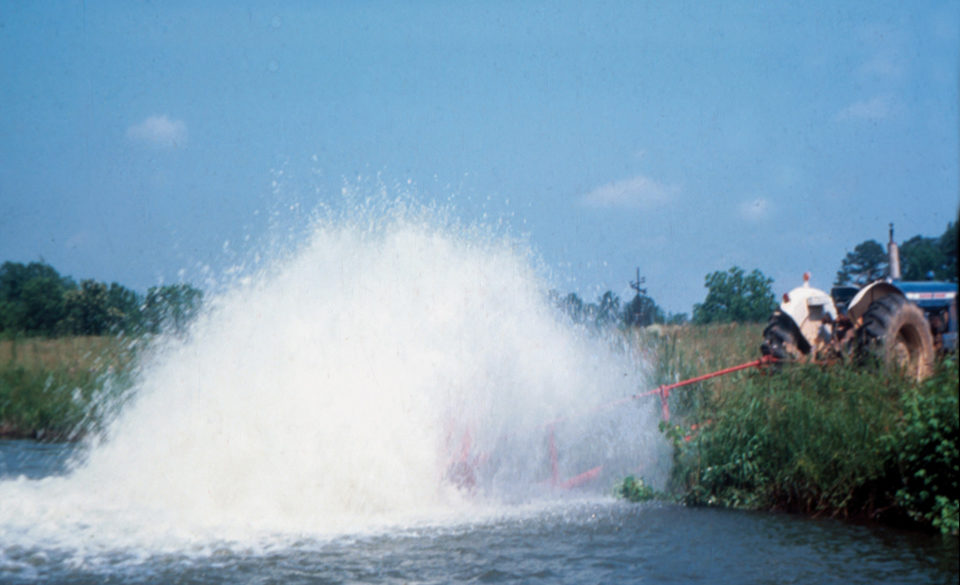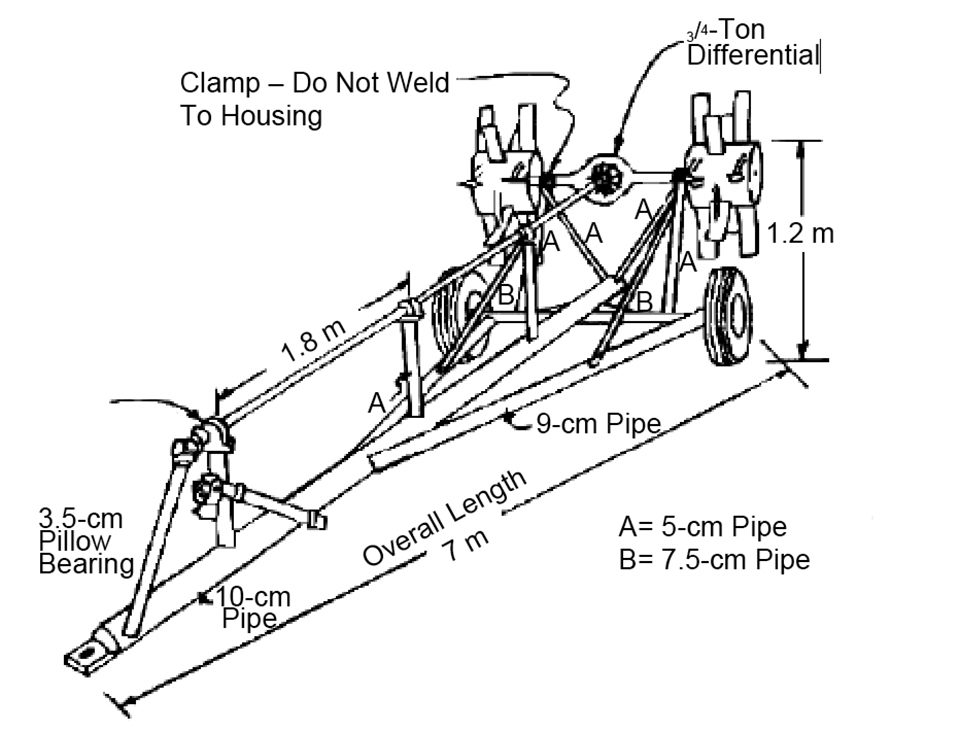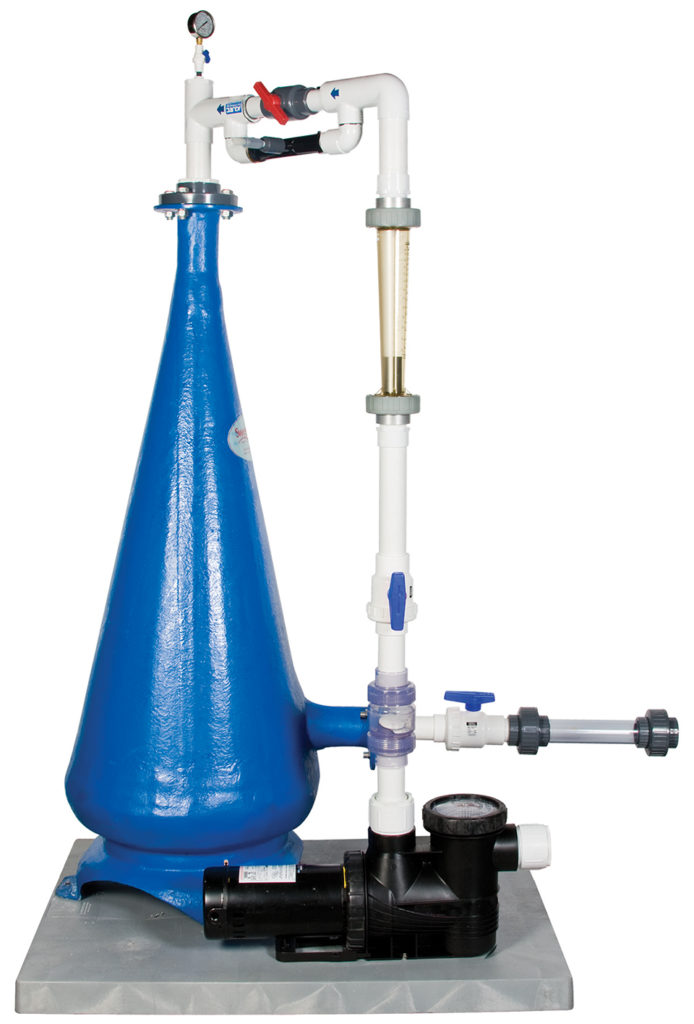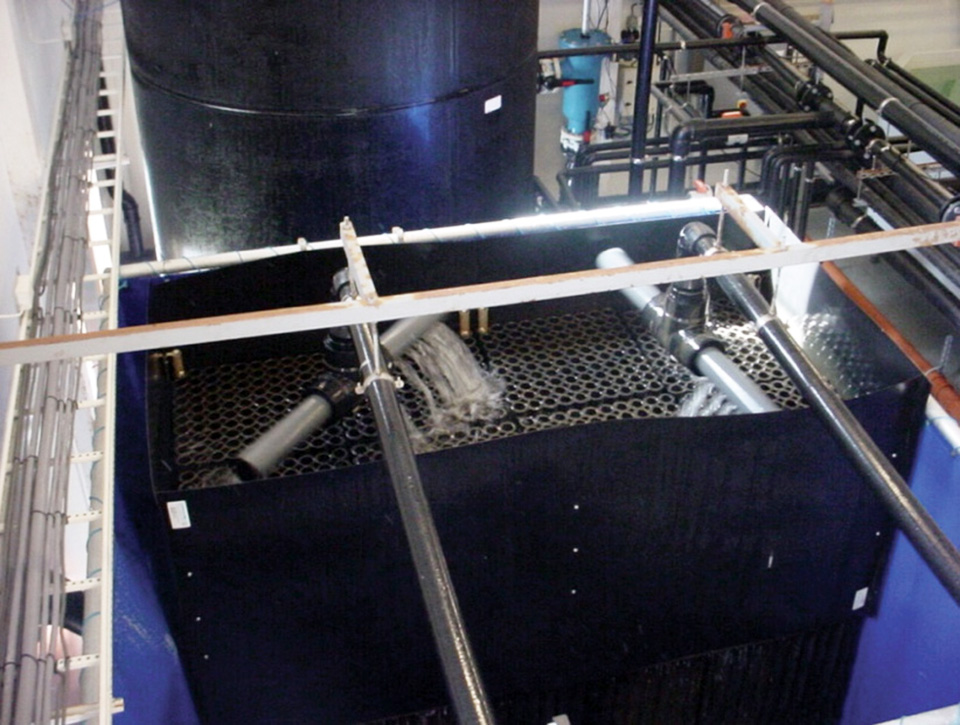Useful devices can be easily and quickly moved from one pond to another

Low dissolved oxygen concentrations can occur in almost any aquaculture pond and lead to stress or mortality in fish, shrimp, or other culture species. Respiration in pond water causes dissolved oxygen concentrations to decline at night, and in ponds with heavy plankton blooms, dangerously low concentrations can occur before dawn. Cloudy weather increases the risk for low dissolved oxygen levels in ponds because the clouds decrease the input of solar radiation and limit oxygen production by phytoplankton photosynthesis during daylight.
Phytoplankton blooms can suddenly die and decompose, an event often referred to as a “die-off.” Such phytoplankton decomposition can cause dissolved oxygen depletion. Application of chemicals such as copper sulfate and diuron for phytoplankton control or formalin and potassium permanganate for disease treatment can kill phytoplankton and trigger episodes of low dissolved oxygen.
Aerators needed
Problems with low dissolved oxygen concentration become more frequent as stocking density and feeding rates increase. Thus, in intensive aquaculture ponds, small, dedicated mechanical aerators powered by electric motors or internal combustion engines are often installed at the beginning of each crop and operated daily to supplement natural sources of dissolved oxygen. In semi-intensive aquaculture, it is not economical to install dedicated aerators in each pond, but some problems with low dissolved oxygen concentrations can occur during most crops.
Even with dedicated aeration, low dissolved oxygen concentrations can develop. Episodes of low dissolved oxygen have a rapid onset and often occur unexpectedly. Immediate response to quickly increase dissolved oxygen availability can avoid serious losses from stress and mortality.
Varied solutions
In the early years of channel catfish farming in the southeastern United States, producers quickly learned that sudden dissolved oxygen depletion could kill most of the fish in a pond. They tried techniques such as flushing ponds with well water, driving a boat with an outboard motor back and forth over pond surfaces to provide aeration, pumping oxygenated water from adjacent ponds into ponds with low oxygen, and using portable pumps to shoot the low-oxygen water into the air to effect oxygenation as it fell back on the pond surface.
All these methods provided a degree of oxygenation and reduced fish mortality. However, none was capable of preventing mortality when dissolved oxygen depletion was severe.
Tractor-powered aerators
In the late 1960s, it was found that the differential and rear axles from a light truck could be used to construct a tractor-powered aerator. This device was attached to a tractor, backed into the pond, and powered by the tractor power take-off (PTO). It splashed a tremendous volume of water into the air to effect aeration and produced a strong water current.
Oxygen-transfer tests conducted at Auburn University revealed that when the paddlewheel aerator depicted was driven by a 65-hp farm tractor, it transferred about 25 kg oxygen per hour. Larger paddlewheels require a more powerful tractor, but transfer proportionally more oxygen to the water.
Portable and efficient
Because of its great capacity to transfer oxygen to water and generate currents to mix the oxygenated water throughout ponds, a single paddlewheel aerator can prevent fish and shrimp mortality during episodes of extremely low dissolved oxygen concentration in ponds up to 8 ha in area.
These devices are especially useful because they can be easily and quickly moved from one pond to another as needed. Usually, improvements in dissolved oxygen concentration can be seen within 30 minutes to two hours.
Farm-built units
Tractor-powered paddlewheel aerators can be purchased from most aquaculture aeration equipment manufacturers in the United States. However, local machine shops or even maintenance shops on large farms can build these aerators. A sketch of a typical design is provided in Fig. 1.

The differential should be from a 0.75- or 1-ton truck, which usually has a speed reduction ratio of 4.0 to 4.5:1. If the farm tractor PTO is operated at 540 rpm, the paddlewheels revolve at 120-135 rpm, an optimum level. The paddlewheel aerator should not be operated at the higher 1,000-rpm PTO speed available on most tractors.
The paddlewheel hub can be made by attaching 46-cm-diameter by 46-cm-long pieces of steel tubing to the wheels. Twelve, 35-cm by 15-cm paddles should be welded to each hub. The most common arrangement of paddles on the hub is three rows of four paddles each per hub.
The paddles in each row are attached 90 degrees apart on the hub. The middle row of paddles should be rotated 45 degrees in relation to the outside rows. A brace attached between the back of each paddle and the hub reinforces the paddle attachment. The paddles can be flat, but slightly concave or triangular paddles tend to scoop the water, making them more effective.
The differential must be mounted upside down on the trailer so the unit’s rotation propels water in the direction of the pond.
The ring gear and pinion teeth in the differential must be securely welded together so both paddlewheels rotate under load. A short piece of copper tubing with the upper tip bent should be attached to the vent hole in the differential with the open end pointed downward to keep water from entering. If the differential does not have a vent hole, the copper tubing can be installed in the oil drain hole.
Minimal maintenance
Paddlewheel operation can erode the pond bottom beneath the aerator. This problem can be lessened by extending the trailer frame behind its tires and welding a 1-meter-wide sheet of steel plate to the frame beneath the paddles.
The completed paddlewheel aerator should be painted to prevent corrosion. The bearings must be regularly lubricated, and the oil in the differential should be changed occasionally. These devices should provide 20 to 30 years of service with minimum maintenance costs.
(Editor’s Note: This article was originally published in the February 2006 print edition of the Global Aquaculture Advocate.)
Now that you've reached the end of the article ...
… please consider supporting GSA’s mission to advance responsible seafood practices through education, advocacy and third-party assurances. The Advocate aims to document the evolution of responsible seafood practices and share the expansive knowledge of our vast network of contributors.
By becoming a Global Seafood Alliance member, you’re ensuring that all of the pre-competitive work we do through member benefits, resources and events can continue. Individual membership costs just $50 a year.
Not a GSA member? Join us.
Author
-

Claude E. Boyd, Ph.D.
Department of Fisheries and Allied Aquacultures
Auburn University
Alabama 36849 USA
Tagged With
Related Posts

Health & Welfare
10 paths to low productivity and profitability with tilapia in sub-Saharan Africa
Tilapia culture in sub-Saharan Africa suffers from low productivity and profitability. A comprehensive management approach is needed to address the root causes.

Responsibility
A look at unit processes in RAS systems
The ability to maintain adequate oxygen levels can be a limiting factor in carrying capacities for RAS. The amount of oxygen required is largely dictated by the feed rate and length of time waste solids remain within the systems.

Responsibility
A look at various intensive shrimp farming systems in Asia
The impact of diseases led some Asian shrimp farming countries to develop biofloc and recirculation aquaculture system (RAS) production technologies. Treating incoming water for culture operations and wastewater treatment are biosecurity measures for disease prevention and control.

Innovation & Investment
A review of unit processes in RAS systems
Since un-ionized ammonia-nitrogen and nitrite-nitrogen are toxic to most finfish, controlling their concentrations in culture tanks is a primary objective in the design of recirculating aquaculture systems.

